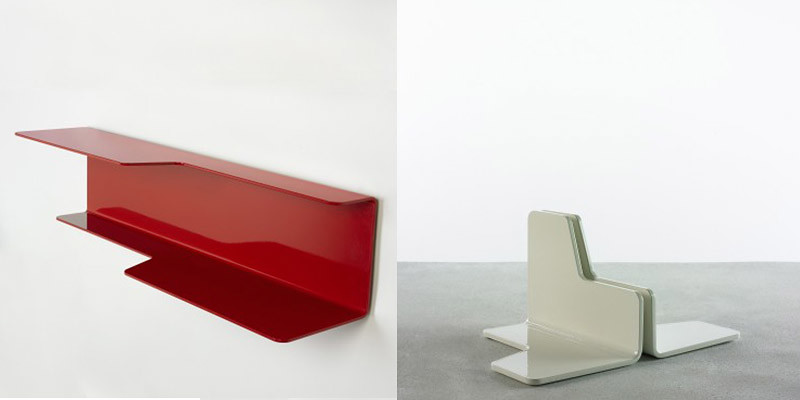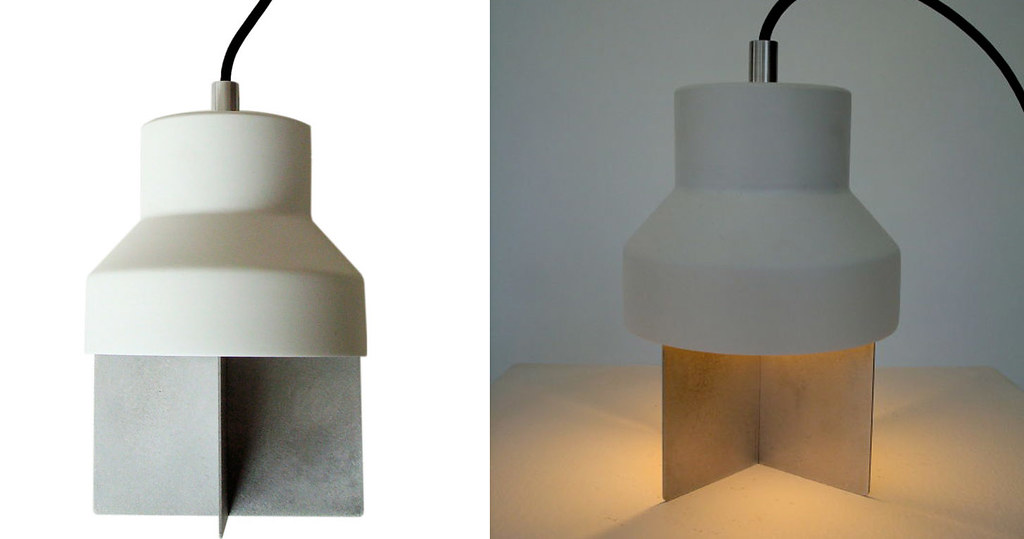"Design to me is like soup. My soup might have carrots in it and yours might as well, but yours will never have the same combination of ingredients because they are being made from a different combination of perspectives and experiences."
- Jonathan Nesci


top image: 4G shelf, waxed and polished water-jet cut 1/4" aluminum plate
bottom images, l to r: Tidal Shelf and Prop Bookends
min·i·mal: barely adequate or the least possible
It was a few years ago that I first saw Jonathan Nesci's minimal works. Sometimes it can take me years to come to grips with a form, a specific color, or a shadow. Have you ever been haunted by a form: fallen madly & deeply in love with its curves or straight edges, only to see it suddenly reappear everywhere? All of a sudden, the fire hydrant's red cylinders, or the lines of the fire escape seem alive and brighter!
Over the past years, I've questioned and considered my attraction towards minimal forms (architecture, design, art). When one reduces color and form to its essence, what exactly is to be gained? In a conversation with Jonathan, I asked him about the word minimal, and he simply stated, "I have no feelings about the word itself other than there is nothing simple about making something that looks simple." And perhaps it is that difficulty that keeps me interested. In Nesci's designs, there is a subtle complexity, a puzzle if you will, that comes to life.
Thanks Jonathan for having this conversation with me about your work.... - David John

Pendant light of powder-coated spun steel, aluminum, magnets from an edition of 20 + 2 AP. Volume Gallery Edition. Edition is sold out. This is number 8. (via Pavillon Antiques)
Design philosophy? I am fascinated with order and systems that are formed from teams of creative thinking. We are surrounded by objects and systems that are made by man that are formed out of want or need. I am in awe of how mankind works together to get something done. I love urban areas because of this; I find myself deep in thought on how and why it all came to be realized. People had to design the roads you drive on, the bridges you cross and the coffee cup that you drink out of. Sometimes their designs work and sometimes they don’t, I like finding the answers to the questions of how and why the most. I am passionately discovering the history of how things came to be and working to add my own flavor to mix. My work is a compilation of all the things that I am personally experiencing.
Design to me is like soup. My soup might have carrots in it and yours might as well, but yours will never have the same combination of ingredients because they are being made from a different combination of perspectives and experiences.
Materials you are attracted to? What is the relationship between the fabricators and yourself? I appreciate the variety of ways to connect materials in general. I like discovering different ways of uniting objects and seem to understand this best with metal. A lot of my work ends up being mono-forms because of this idea of seamless uniting until visually the parts become a whole.
Because of low quantity orders and continuous prototyping, I am at the fabricator's mercy for pricing and lead times. There are talented people out there who take small orders and I do my best to find them and stay on their good side. I’m always asking questions to fully understand their process and design around their capabilities. I’ve tried welding, grinding, machining myself and have come to realize I will never do as good of job than someone who does it every day. I love the variety of things that can be done in a industrial process without me being there while it is being made, it frees me up to work on new designs with other processes simultaneously.
You were restoration manager for WRIGHT AUCTIONS, can you talk about this experience and the effect it has had upon your work? The most unforgettable object you worked with there? I benefited from five years of solving design problems and soaking in important historical design. Prior to this I had a 3D CAD certification with a limited knowledge of design history. While I was at Wright I was exposed to a variety of craftsmen who were experts in processes with all different types of materials. It was a great opportunity to develop relationships with many talented people and get 10,000 hours of precious design and fabrication practice. Richard Wright and his late-wife Julie were monumental in training and supporting my work and I am very grateful for the chance they took in me.
There were so many unbelievable pieces at Wright. I feel like every piece I touched had some type of impact on my vocabulary of scale, connections, and materials. If I had to choose one it would be Scott Burton's Hectapod table, I absolutely love that piece.
Any periods in historical time, or specific designers that you are attracted to? I'm really drawn to artists who work with design sensibilities such as Burton, Brancusi, Noguchi, Albers, Judd, Tony Smith, Max Bill etc.. Most of them worked with craftsmen to fabricate their work and I like this idea of working with others to carry out your ideas.
In a very short time you have been not only able to design quite a large portfolio of works, but also be awarded and recognized. Any advice for the young designer? Make your ideas into physical objects even if they are only full-scale mock-ups. The ideas can't stay in a gestation state in your notebook. They need to be born, from there they can be refined.

Technically speaking, this piece started as a rough sketch and was quickly brought in 3D CAD to work its assembly. It then had to be deconstructed from a 3D drawing back to a 2D file to water-jet cut the aluminum. Once I had a cut file I did multiple full-scale mock-ups in 1/4" thick Luan sheet to refine the form. From there I made corrections to the cut file and started the fabrication process.
Artists & designers such as Tony Smith, Donald Judd, Sol Lewitt appear to inform your work. What is the building block you hope to add to this conversation surrounding minimal design? I am most interested in how my ideas relate to the industrial process; I’m not sure how this adds to minimal design specifically. I'm constantly experimenting so I really never know where it'll all end up. I'd like to have a design that sells really well one day so I can advance my research in what else can be done. I really love this aspect of design thinking that you really don’t know what great answer to your problem that tomorrow will bring.
3 things I had no idea about Jonathan Nesci?
I'm continually changing my mind. This makes personal and business relationships very interesting. Nothing says “this guy is crazy” more than having a idea you feel great about one day change completely overnight. This is how I work out problems though; I have to see it physically to see if it’s working.
I'm itching to have large scale sculpture produced. Design should work; whether it works as a chair or works as a sculpture doesn’t really matter to me. I would love the opportunity to make a sculpture that works as a sculpture.
I have no idea what I'm doing, but I learn a little bit everyday of what I don't want to do and try to do less of that. I like what my friend told me: “Just keep swimming and try not to breath in too much water." This seems to sum up a lot of what I’m trying to do. It’s an experimental journey to me.
Future Exhibtions? I have a solo show in November with Patrick Parrish’s gallery MONDO CANE. He has an great space in Tribeca and I love the design history roots that the gallery has.

jack stool
HALE, an industrial design company founded by Jonathan Nesci in 2006, is a part-design, part-production firm based dually in Chicago, IL and Scottsburg, IN.
HALE uses a direct, intimate approach in securing quality, detailed, decorative art and fine furniture products from craftsmen in fields beyond the furnishing markets. In many cases, the designs are formed around industry capabilities and employ experts in a variety of manufacturing and production processes.
